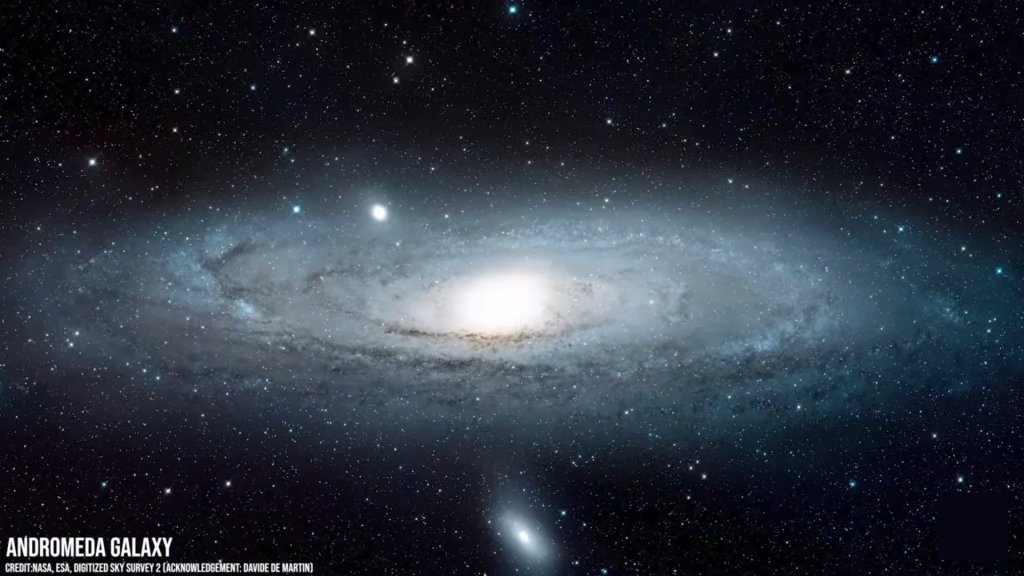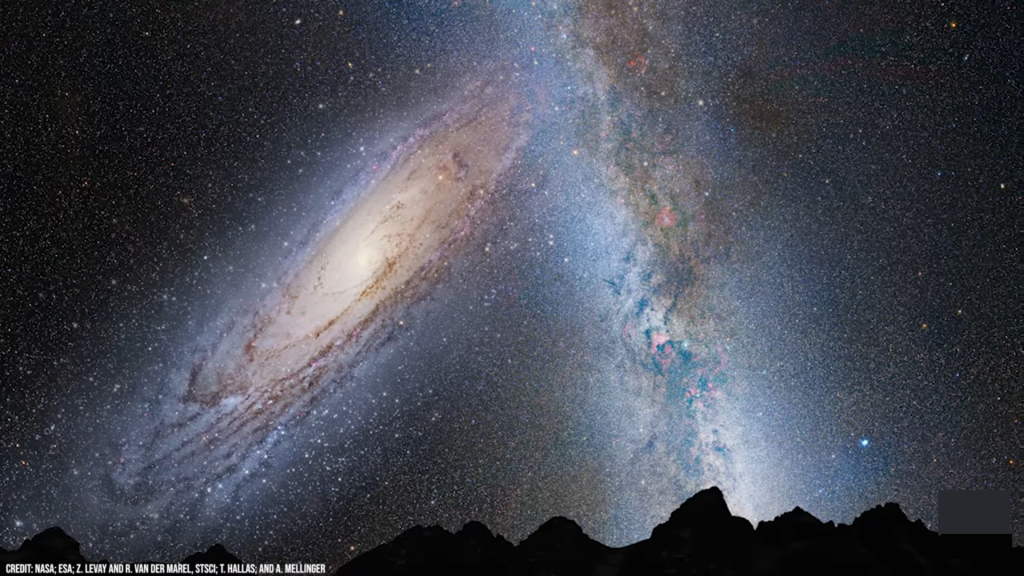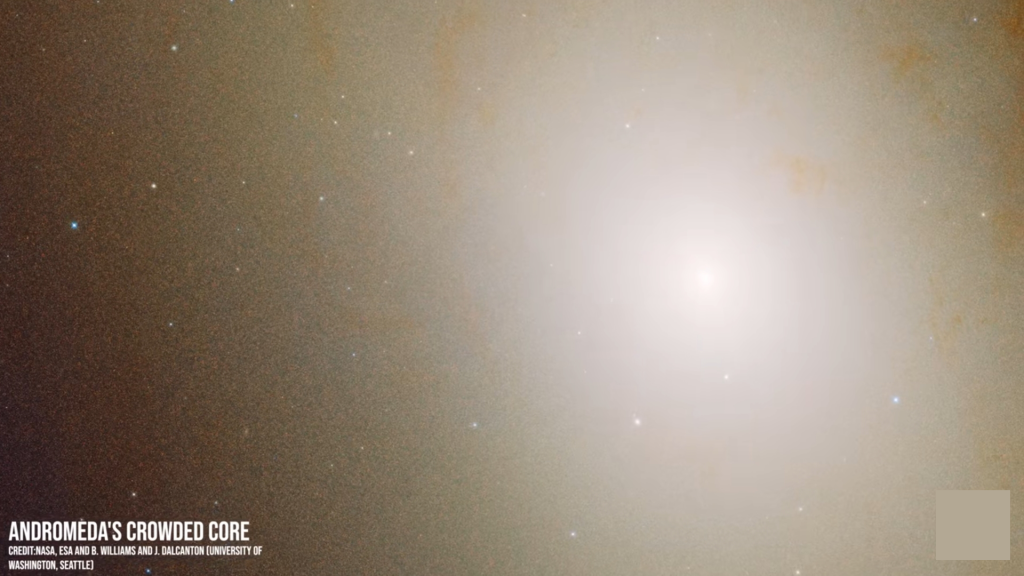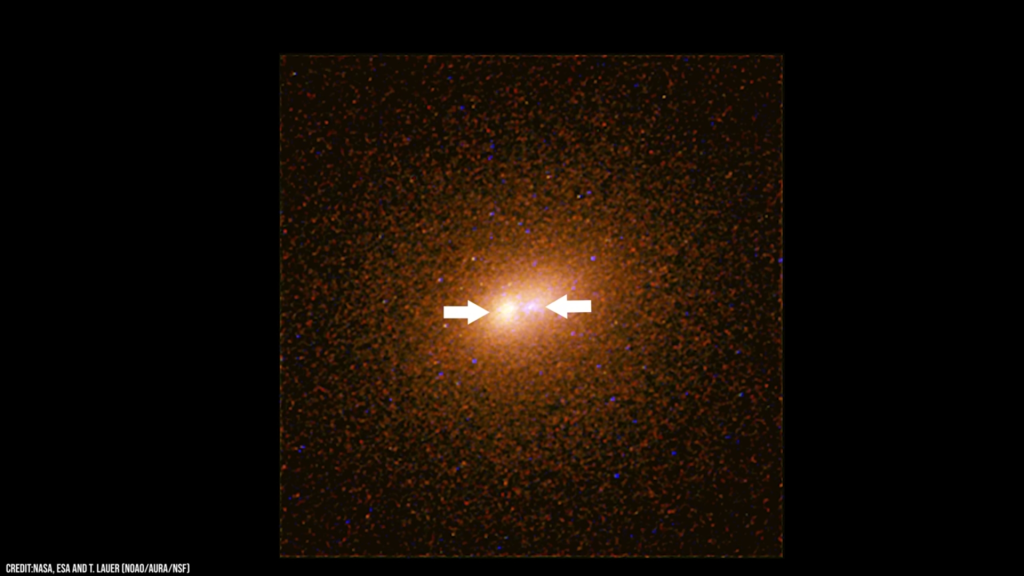
Surrounding the Milky Way galaxy are over 30 other galaxies that are considered to be a part of what is called the local group. But our galactic home is not the largest, we have a big sister, called the Andromeda Galaxy. Although it is one of the closest to our own, it is still 2.5 million light-years away which is an unimaginable distance.
Like the Milky Way, Andromeda is also a spiral galaxy. The reason we can think of it as a big sister is that there are many similarities between the two, but Andromeda is much larger. In fact, It is so large and so bright, it is the most distant object you can see with just the naked eye.
Andromeda is a colossal galaxy and contains over a trillion stars, whereas the Milky Way contains 200‐400 billion stars. Andromeda is around twice as wide as our galaxy measuring more than 200,000 light years in diameter. So how did this enormous neighbour of ours grow so big? and what is lurking within its extremely bright galactic centre?
Both the Milky Way and Andromeda likely formed around the same time near the beginning of the Universe, 13.5 billion years ago. These two galaxies have grown throughout their lifetimes by consuming other galaxies they have collided with. And one day, our Milky Way galaxy too will collide with Andromeda.
While the initial collision is estimated to take place in around 4 billion years from now, computer simulations predict that it will take another two billion years for the galaxies to completely merge. Once merged, we will no longer be a spiral galaxy, with magnificent extending arms of bright stars, but instead, we will have morphed into one enormous mass of stars, called an elliptical Galaxy.

Above is an artist’s depiction of what our sky might look like just before this monumental merging. Another similarity between the Milky Way and Andromeda is that they both have a central bulge packed with bright stars, and lurking at the very centre of all these stars, they both are hiding a gravitational monster. A supermassive black hole.
Supermassive black holes are just that, black holes that are extremely massive, weighing anywhere between millions to billions of times the mass of our Sun. Astronomers do not know exactly why these mysterious dark objects grow to be so massive, but they believe it could be linked to their presence at the centre of their host galaxy.
Not so long ago, the supermassive black hole at the heart of the Milky Way, called Sagittarius A* was captured for the first time as the spectacular image above reveals. It is assumed that at the core of nearly every massive galaxy in the universe, another supermassive black hole can be found.

While stunning images such as the one above, show Andromeda’s extremely bright central bulge of bright stars enveloping its hidden black hole, in 1993 astronomers were surprised to discover two blobs of light surrounding the core. One appearing blue and the other appearing red.

By 2012, astronomers had understood that the blue blob is a cluster of young, hot stars surrounding Andromeda’s supermassive black hole, a feature also found at the core of the Milky Way, indicating that this may be a common feature in many galaxies.
The red blob at Andromeda’s core, however, are actually a lopsided elliptical disk of older stars surrounding the blue cluster and the supermassive black hole. We do not see this red stellar disk in the Milky way, leading astronomers to investigate what happened in Andromeda’s past that could have created this mysterious disk and what made it lopsided?
Recently, astronomers may have found an answer to this question, and It involves a colossal cosmic collision. The supermassive black hole at the centre of Andromeda is about 100 million times the mass of our Sun, and about 25 times more massive than Sagittarius A*.
Andromeda’s black hole was not likely born this massive, but grew over its lifetime by devouring any object it came into contact with, even other black holes. And it is this cosmic-sized appetite, that may have created the mysterious lopsided disk of ancient stars discovered at Andromeda’s heart. So what exactly could have happened? Well, The assumed timeline of the events is proposed to have played out as follows.
Over a billion years ago a galaxy collides and begins to merge with Andromeda. The black hole from the colliding galaxy drops closer to Andromeda’s larger black hole and they begin to orbit each other, in a violent dance. As this happens, material from the galaxies falls towards the black holes and begins to orbit a few light years away. This material eventually condenses and forms new stars, creating a ring around the black holes.
Finally, the black holes merge in a powerful event, producing a burst of gravitational waves. If one of these merging black holes is much smaller than the other, this burst may not radiate evenly in all directions but can be more focused one way or the other. This lopsided blast can give the newly formed black hole a kick in one direction, resulting in it shooting off at high speeds, potentially at 200 km per second. Which is around 125 miles per second.
As this happens the orbiting stars get a kick as well and their circular orbits get disturbed creating a new elliptical orbit. With this new orbit, they speed up as they get closer to the black hole, then slow down when they are further away. This is possibly why the disk we see in Andromeda’s centre looks lopsided with one much brighter side. There is a pile-up of stars as they slow down when they are further from the black hole.
The blobs of blue stars we see are younger so they would have come along a lot later through a few different possible scenarios. But this however is only one possible series of events that could have resulted in what we see today at the centre of Andromeda. While this new work is a great first step in understanding what is going on, it is just a start. As technology improves, we will be able to dig ever deeper into the cores of nearby galaxies, giving us more insight into how galaxies like Andromeda and even our own have evolved over the billions of years they have existed.


